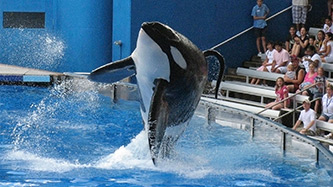Did you enjoy your visit to Seaworld as much as I did? Judging from the footage in the cheesy info-spot that was shown on the Jumbotron at Shamu Stadium, it sure looks like you did. This, of course, was back in the 80s. I was there in '81, and had my picture taken with Shamu. I even bought a plush whale toy and a Seaworld hat that I wore non-stop for the next year. Like most 8 year-olds, I thought Shamu was a superstar. I didn't consider the circumstances under which he and the other animal performers lived. But hey, it was the 80s--people smoked on planes and used baby oil instead of sunscreen. We didn't know any better.
But we do now. At least we should, according to the makers of the documentary Blackfish.
Director Gabriela Cowperthwaite initially set out to investigate how Dawn Brancheau, an experienced trainer, could be killed by a whale. In doing so, she uncovered the sad and shocking truth behind one of America's most popular theme parks. Blackfish reveals the true implications of keeping killer whales in captivity for our amusement.
In the aforementioned video clip, you enlightened Seaworld visitors with your trademark sonorous voice about how difficult it is to become an animal trainer. The former Seaworld trainers interviewed in Blackfish were all inspired to work with whales after visiting the park as children, but imagined (as you implied) that the job would involve years of intensive education in Marine biology. This, however, is not the case. Turns out, the less they knew about killer whales, the better. In fact, the documentary exposes a culture of systematic misinformation at Seaworld, from basic knowledge about the animals in their charge, to the backstory of Tilikum, the killer whale at the heart of Blackfish's tragic narrative.
I can't imagine you knew any of this when you agreed to make your Seaworld video.
In 1991, Sealand of the Pacific in Victoria B.C. was the kind of run-down attraction people went to ironically. There was no way they could have afforded to hire a star of your caliber to film an entertaining short. It was little more than a penned in harbour that kept whales in dark, cramped cells when they weren't performing. Having been trained by negative reinforcement, Tilikum was Sealand's ticking time bomb. When he drowned his trainer Keltie Byrne after a show, the owners closed the park and sold Tilikum to Seaworld Orlando, ostensibly to be used as a breeder. None of the Seaworld trainers knew Tilikum was dangerous. But apparently the higher-ups did, and it didn't stop them from allowing him to perform.
He would go on to kill two more times.
We learn, from an ashamed former fisherman who trapped whales in Puget Sound in the 70s, that after a baby whale was separated from it's pod and netted, the rest of its family would remain close by and cry in dismay. He tearfully recalled his job as nothing more than kidnapping. We meet a neuroscientist who has studied whale's brains, noting that they have a section that humans don't possess; a section that suggests they have highly elaborate emotional capabilities. But it's more than just neuroscience. Whales have a complex social system wherein they are bonded to their pod for life. Forcing artificial bonds on them in captivity almost always results in aggression. In short, the practice of catching, training, and confining whales creates the perfect conditions under which a whale will kill. And how do we know this isn't instinctual behavior? Because, as we learn, there has never been an instance in which an Orca has killed a human in the wild.
I get the feeling that none of this information was in your script.
With extensive interviews and an impressive amount of footage, Cowperthwaite stops just short of exploitation. We see bloodied, injured whales and quick cuts of many different trainers over the years being nearly drowned or crushed, a stark contrast to the sunny (yet misleading) commercials and videos (like yours) fed to the public. If this paints a one-sided picture, it might be because, despite numerous requests, Seaworld refused to participate in the making of this film. Though I'm not sure they could have made a convincing case in their favour.
It doesn't help that they hired Darth Vader.
Deepest regards,
Di







